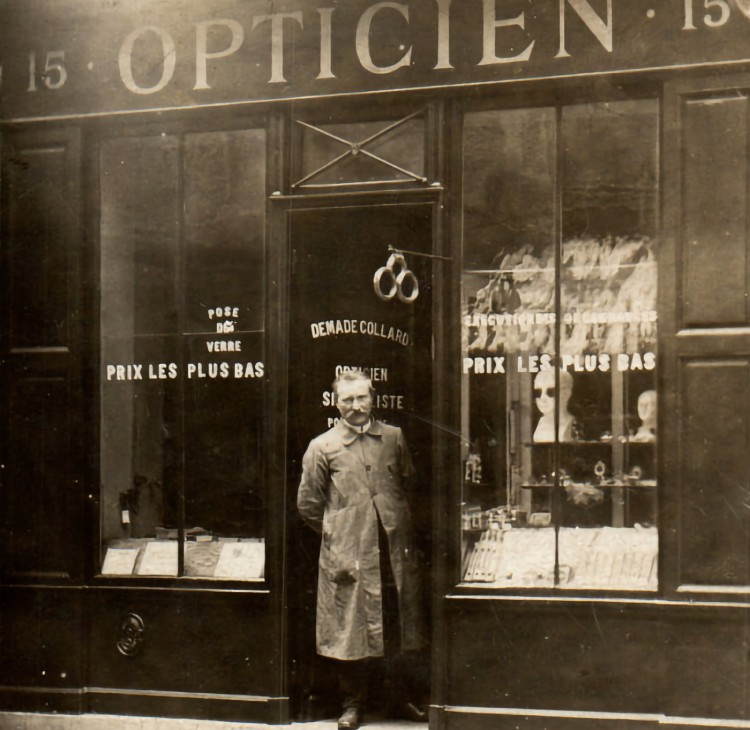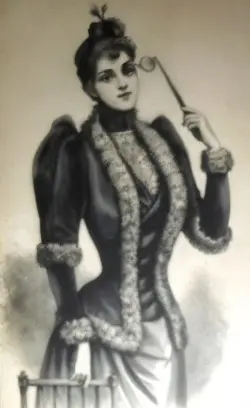
Credits: Ein Optiker - Public Domain
Suddenly perceptive
In the popular series »Look, there used to be something like this«, this time we are presenting a device whose usefulness has been questioned since the late 18th century at the latest - but which held its own well into the 20th century. Anyone who would think of wearing this accessory - the lorgnette - in public today would probably want to cause a fashionable stir.
If I met someone using a lorgnette, I would have been unable to call it anything other than »that thing« or »those glasses«. I would have known what it was for, but I would have had no idea what to call it. It really isn't difficult to guess how I came to this topic.

Lucas had gone to the Comtesse in the Rue des Pyramides. As she was asleep, he had to wait a long time. Finally, she received him in a gauzy robe. A grande dame, the Comtesse! With a lorgnette. She persistently addressed Lucas as »Monsieur l'agent«.
The German term »Stielbrille« would have been more catchy, immediately understandable. Especially in combination with the Comtesse's appearance as described, it sounds less elegant. The lady's appearance - whether in a robe or not - takes on a certain elegance and cosmopolitanism through the use of the term. (At least in translation ... I have no idea how the French feel about the term).
The term »Stielbrille« has a disadvantage, which is cleverly ironed out by the words borrowed from the French language. When we talk about a lorgnette, we mean a visual aid that has a handle and two lenses. A handle with one lens can be called a lorgnon.
I had two questions: Should I have known the term? Why hold glasses when there were spectacles with temples - or were these invented later?
Nööööö
The use of the term in the German language had its heyday in the first half of the 18th century. Napoleon invaded the German lands and the term became fashionable. After that, it rapidly declined until there was a small upward trend in the use of the word at the beginning of the 20th century.
After 1946, the term was used extremely rarely - at least in relation to the corpus of the German language examined, which consists of newspapers. Last year, the word was used three times.
Amusingly, this corresponds exactly to the occurrence of the word in the Maigret translations. I could have noticed the visual aid on two other occasions: In both »Maigret and Pietr the Latvian« and »Maigret Loses an Admirer«, a lorgnette was mentioned in each case. In later works, Simenon no longer used this accessory for his characters.
The situation with the lorgnette is more complicated: the single-lens version was only mentioned once in the translations of the Maigret stories. In »One does not kill poor people« it is said:
And, adjusting his lorgnon, he repeated:
»Mr. Tremblet has not been in our service for seven years.«
The question that arises at this point for those now in the know: What is he adjusting? If a lorgnon is a pair of glasses on a stem, then the man would just be holding his glasses differently ...
This became even more confusing when the search was extended to the French originals. It turned out that Simenon used the term "lorgnon" quite frequently: one example is the story »Madame Maigret's Lover«, which states:
»D'abord, il se sert d'une canne et tu as toujours aimé les hommes qui marchent avec une canne… Je parie qu'il porte lorgnon...«
Übersetzt wurde das mit:
»Oh yeah? First of all, he has a walking stick, and you always had a thing for men with walking sticks, and I bet he wears a pince-nez too...«
Looking it up in the dictionary shows that this is the common translation. However, no reference is made to a possible stem.
Research with our French friends revealed that they have a slightly different nomenclature. They differentiate between a »lorgnon monocle« and a »lorgnon binocle«. As we know, monocles are glasses that you clamp in front of your eyes - which is supposed to be less uncomfortable than it sounds; a binocle is a pair of glasses without temples that have been clamped onto your nose - which fits in with a pince-nez.
If something in the poor man's story had been adjusted, it could be a monocle or a pince-nez. The latter seems more likely.
The French have no word for the variant of just attaching a glass to a stem. But to be honest, this was a secondary question.
I would answer »no« to the question of whether I should have known the term.
The second question
Spectacles with temples were already in use at the end of the 18th century. This quickly settles the question of whether spectacle temples existed.
From this, it could be concluded that the lorgnette was a mistake. However, the ladies of the time would have strongly disagreed with this, and not just from a fashion point of view.
An etymological examination reveals why the accessory enjoyed a certain popularity in high society in the 19th century. The word »lorgnette« comes from the French »lorgner«, which means »to look furtively« or »to look from the side«.
Now, lifting a stem topped by two glasses cannot be called stealthy. The trick was that the glasses were initially incorporated into compartments and in this way the surroundings could actually be observed without attracting attention.
At one point in my research, I read that the use of a lorgnette (and of course its single-lens sibling) is now considered eccentric.
There is nothing to add to that.




